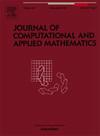Longitudinal quantile-based regression models using multivariate asymmetric heavy-tailed distributions and leapfrog HMC algorithm
IF 2.1
2区 数学
Q1 MATHEMATICS, APPLIED
Journal of Computational and Applied Mathematics
Pub Date : 2025-04-15
DOI:10.1016/j.cam.2025.116690
引用次数: 0
Abstract
Modeling longitudinal quantile regression in a multivariate framework poses particular computational and conceptual challenges due to the inherent complexity of multivariate dependencies. While univariate quantile-based models can be extended to higher dimensions via Gram-Schmidt orthogonalization, such extensions often have practical limitations. To address these challenges, this paper introduces a flexible family of multivariate asymmetric distributions using the probabilistic Rosenblatt transformation. This framework preserves conditional coherence across longitudinal quantile processes via a sequential likelihood factorization, provides an explicit characterization of quantiles shaped by distributional asymmetry and covariate effects, controls for the influence of outliers, and improves computational efficiency in the estimation process. For Bayesian inference, we implement a leapfrog Hamiltonian Monte Carlo algorithm with the No-U-Turn Sampler to estimate longitudinal quantile-based regression parameters. Simulation studies over various quantile levels demonstrate the method’s theoretical properties, while two empirical applications highlight its practical utility and superior performance.
基于多变量非对称重尾分布和跨越式HMC算法的纵向分位数回归模型
由于多变量依赖关系固有的复杂性,在多变量框架中建模纵向分位数回归提出了特殊的计算和概念挑战。虽然基于单变量分位数的模型可以通过Gram-Schmidt正交扩展到更高的维度,但这种扩展通常具有实际的局限性。为了解决这些问题,本文利用概率Rosenblatt变换引入了一组灵活的多元非对称分布。该框架通过顺序似然分解保持纵向分位数过程的条件一致性,提供了由分布不对称和协变量效应形成的分位数的明确表征,控制了异常值的影响,并提高了估计过程中的计算效率。对于贝叶斯推理,我们实现了一个带有No-U-Turn采样器的跨越式哈密顿蒙特卡罗算法来估计基于纵向分位数的回归参数。在不同分位数水平上的仿真研究证明了该方法的理论特性,而两个经验应用则突出了其实际效用和优越的性能。
本文章由计算机程序翻译,如有差异,请以英文原文为准。
求助全文
约1分钟内获得全文
求助全文
来源期刊
CiteScore
5.40
自引率
4.20%
发文量
437
审稿时长
3.0 months
期刊介绍:
The Journal of Computational and Applied Mathematics publishes original papers of high scientific value in all areas of computational and applied mathematics. The main interest of the Journal is in papers that describe and analyze new computational techniques for solving scientific or engineering problems. Also the improved analysis, including the effectiveness and applicability, of existing methods and algorithms is of importance. The computational efficiency (e.g. the convergence, stability, accuracy, ...) should be proved and illustrated by nontrivial numerical examples. Papers describing only variants of existing methods, without adding significant new computational properties are not of interest.
The audience consists of: applied mathematicians, numerical analysts, computational scientists and engineers.

 求助内容:
求助内容: 应助结果提醒方式:
应助结果提醒方式:


